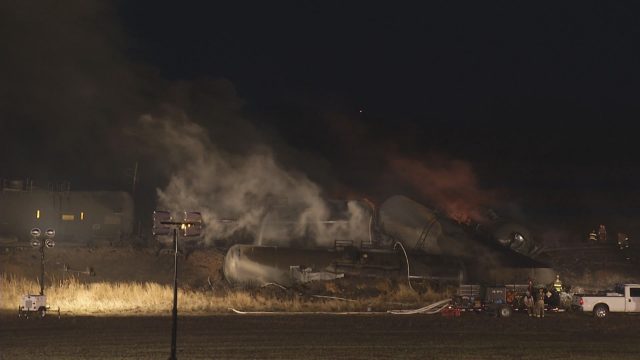Heimdal Derailment Shows That Oil Train Problem Is Improving

Earlier this week another oil train derailed, this time near Heimdal in central North Dakota.
Anti-oil activists could almost be heard panting in their excitement, rushing to the media with talking points about “bomb trains” and lax regulation of oil shipped on America’s rail lines. Rep. Ron Guggisberg, a North Dakota Democrat from Fargo, went on MSNBC to make political hay claiming that the state’s first responders aren’t prepared for these derailments.
But cutting through the miasma of anti-oil politics that surrounds these incidents, we learned a couple of very positive things that fly in the face of the narrative pushed by the activists and partisan opportunists like Guggisberg.
For one thing, despite what Guggisberg claims, North Dakota’s first responders were prepared for this derailment and responded to it in admirable fashion. And you don’t have to take my word for it. That’s what Senator Heidi Heitkamp had to say:
A fire-training event put on by a rail company last year provided the perfect script for Harvey and Fessenden firefighters in battling the blaze from derailed oil tankers near Heimdal Wednesday.
North Dakota Sen. Heidi Heitkamp, who met with the first responders to the fire Friday, said the group reported feeling completely prepared.
The volunteer firefighters stated the regional training put on by Burlington Northern Santa Fe Railroad in New Rockford after the December 2013 derailment and oil fire near Casselton taught them exactly what they needed to know, she said.
As for the “bomb trains” narrative, it turns out that while there was certainly a fire at the Heimdal derailment, there were no explosions something that is likely the result of new oil conditioning requirements North Dakota’s Republican leadership put in place which went into law on April 1st.
The oil tanker cars involved in Wednesday’s/last week’s train derailment near Heimdal (hyme-doll), North Dakota caught fire but did not explode. …
In April, North Dakota began requiring companies to remove the most flammable gasses from crude oil and lower its vapor pressure before loading it onto trains. The goal was to prevent an explosion during a crash.
It seems that, so far, that goal has been achieved. As I reported on Thursday, the oil on the Heimdal train was tested at 10.83 psi, about 21 percent lower than the maximum allowed under the state’s new rules.
The larger point here is that our state’s leaders have responded to the lessons of earlier oil train derailments – the one in Casselton in particular – in an admirable fashion. And it’s working.
There are still areas for improvement. The rail cars that derailed and ruptured near Heimdal were of a sort being phased out in favor of more secure tankers. That process needs to be hastened. We also need to figure out how something like the broken wheel that’s suspected as the cause of the Heimdal derailment per preliminary findings made it past industry and government mechanical inspectors.
But while the usual suspects – whose motivations are less common sense regulation than a full stop to fossil fuel development and/or electoral gains – rant on the editorial pages and cable television North Dakotans can rest assured that this problem with oil train derailments is improving.




